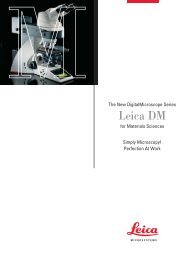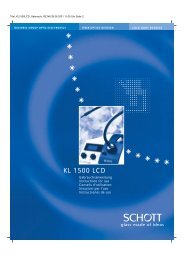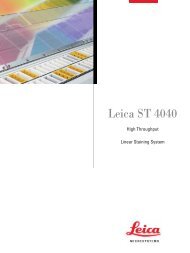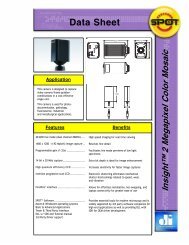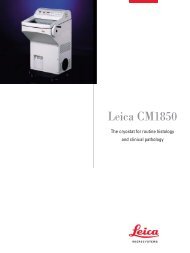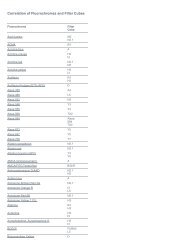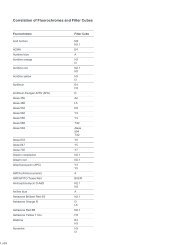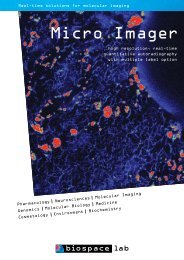MICROMANIPULATION - Meyer Instruments, Inc.
MICROMANIPULATION - Meyer Instruments, Inc.
MICROMANIPULATION - Meyer Instruments, Inc.
You also want an ePaper? Increase the reach of your titles
YUMPU automatically turns print PDFs into web optimized ePapers that Google loves.
<strong>MICROMANIPULATION</strong><br />
DSA Application days LSR<br />
Sept., 15th -18th 09<br />
Living up to Life<br />
Werner Wittke
The Leitz<br />
Micromanipulator<br />
1952<br />
The Leitz Labovert<br />
Märzhäuser<br />
Micromanipulator<br />
1981<br />
The Leica DMIRE2<br />
Leica<br />
Micromanipulator<br />
2004<br />
Leica<br />
Micromanipulation<br />
History<br />
The Leica ASTP<br />
2004<br />
Living up to Life<br />
The Leica AM6000<br />
2006
• Success story IMSI<br />
– ESHRE<br />
–IVF<br />
• Micromanipulators<br />
• Applications<br />
Content<br />
Living up to Life
IMSI System<br />
–DMI microscope or AM6000<br />
–Micromanipulator<br />
–Objective 100x, DIC<br />
– + 2x Mag changer<br />
– + vario1.6x Zoom c-mount<br />
– + camera/monitor factor (50)<br />
= 16000X magnification at the monitor<br />
IMSI<br />
Intracytoplasmic morphology selected sperm injected<br />
Optical magnification of sperms<br />
via light microscopy in order to correlate morphology with quality<br />
Living up to Life
„Standard Image“<br />
ICSI<br />
20X objective<br />
IMSI<br />
Intracytoplasmic Morphology selected Sperm Injected<br />
Living up to Life
Correlation of morphology<br />
with quality -<br />
HOW DOES A<br />
„GOOD“ SPERM<br />
LOOKS LIKE ?<br />
IMSI<br />
Intracytoplasmic Morphology selected Sperm Injected<br />
Living up to Life<br />
vacuoles
ESHRE Poster 07-09<br />
Living up to Life
Since 2007<br />
Approx. >30 IMSI<br />
systems sold<br />
Living up to Life<br />
ANSP: around 100k€<br />
EU, J, Asia, Afrika
IMSI<br />
Living up to Life
New IVF brochure<br />
Living up to Life
Living up to Life
Living up to Life
New IVF brochure<br />
supports Leica IVF portfolio:<br />
Inverted microscope<br />
Upright microscopes<br />
Stereo microscopes<br />
and accessories in IVF<br />
Living up to Life
Our IMSI/IVF Reference lab<br />
• Prof Stephane Viville, Strassbourg, France<br />
Possibilty to visit this lab with customers<br />
– He and his coworker (Dr. Christiane Wittemer) will give<br />
lectures during IVF congresses<br />
– Give application support<br />
– IMSI courses<br />
Living up to Life
Manipulators<br />
Living up to Life
Narishige Co-operation<br />
• New Narishige manipulators<br />
• Narishige peripheral equipment<br />
<strong>MICROMANIPULATION</strong><br />
Leica<br />
manipulator<br />
AM 6000<br />
Living up to Life<br />
Eppendorf Co-operation<br />
• Leica AM6000<br />
• Epp. Peripheral equipment
Mechanic Micromanipulators<br />
Leica<br />
Hydraulic Micromanipulators<br />
Narishige<br />
Electronic Micromanipulators<br />
Eppendorf<br />
Living up to Life
Leica Mechanic Micromanipulators<br />
Features:<br />
Continuously selectable gear reduction<br />
Tension control<br />
Translation, directly and without any backlash<br />
3 separate gears (fine and coarse) for x,y and z<br />
1 tilting gear ( 0° - 15° )<br />
1 multidirection hanging joystick<br />
Living up to Life
Leica Mechanic Micromanipulators<br />
Features:<br />
No movements of inertia to overcome<br />
when moving to specimen details<br />
precise and straight movements of the<br />
micro-instruments give optimum results<br />
maximum tool positioning accuracy even<br />
at high magnification<br />
Smallest travel range approx. 0,25 µm<br />
Living up to Life
Leica Mechanic Micromanipulators<br />
Features:<br />
Reliable functioning<br />
rapid pre-alignment of the micro tools with the<br />
individually adjustable instrument holders, -<br />
saving valuable time<br />
excellent user convenience – hands rest in a<br />
comfortable position on the base plate<br />
can carry weight around 200 g<br />
Living up to Life
Leica Mechanic Micromanipulators<br />
Features:<br />
no vibration : e.g. by motors<br />
no delay : hydraulic, electronic<br />
feeling : “you fell the touch”<br />
perfect : precise mechanic<br />
Living up to Life<br />
Applications:<br />
mechanical advantages others than mechanical<br />
slow but precise work routine work<br />
simple holding function more sophisticated<br />
single cells or objects adherent cell culture<br />
ooccyte/ blastocyt injection large quantity
Leica Mechanic Micromanipulators<br />
Accessories:<br />
Single instrument holder<br />
Double instrument holder<br />
Instrument sleeves to hold the tips<br />
Spacer for DMÍ-Series to hold the instruments<br />
Base plate for DM IL or DMI-Series<br />
Living up to Life
Leica Mechanic Micromanipulators<br />
Versions:<br />
Micromanipulator L<br />
(for the left site of Microscope)<br />
Micromanipulator R<br />
(for the right site of Microscope)<br />
(to achieve the right turn direction for the Z-axis)<br />
Living up to Life
Capillary<br />
movement<br />
Capillaries<br />
Capillary<br />
movement<br />
Living up to Life
Application Set up: ‘TRANSGENIC<br />
Motorized‘<br />
Leica DMI 3000/4000/6000<br />
NL-11 : 1 unit<br />
Mounting Adaptor<br />
Living up to Life<br />
MOM-202D : 2 units<br />
Three-axis Oil Hydraulic Joystickcontrolled<br />
Micromanipulator<br />
(integrated with Motorized Coarse<br />
Manipulator)<br />
IM-300 : 1 unit<br />
Motorized Microinjector
Application Set up: ‘TRANSGENIC<br />
Manual‘<br />
Leica DMI3000/4000/6000<br />
NL-11 : 1 unit<br />
Mounting Adaptor<br />
Living up to Life<br />
MON-202D : 2 units<br />
Three-axis Oil Hydraulic Joystickcontrolled<br />
Micromanipulator<br />
(integrated with Manual Coarse<br />
Manipulator)<br />
IM-300 : 1 unit<br />
Motorized Microinjector (requires<br />
separate pressure source)
Application Set up: ‘ICSI motorized‘<br />
Leica DMI 3000<br />
NL-11 : 1 unit<br />
Mounting Adaptor<br />
MOM-202D : 2 units<br />
Three-axis Oil Hydraulic Joystickcontrolled<br />
Micromanipulator<br />
(integrated with Motorized Coarse<br />
Manipulator)<br />
IM-9B : 1 unit<br />
Microinjector (for Injection):<br />
IM-9C : 1 unit<br />
Injector (for Holding)<br />
Living up to Life
Application Set up: 'ICSI manual‘<br />
Leica DMI 3000<br />
NL-11 : 1 unit<br />
Mounting Adaptor<br />
MON-202D : 2 units<br />
Three-axis Oil Hydraulic Joystickcontrolled<br />
Micromanipulator<br />
(integrated with Manual Coarse<br />
Manipulator)<br />
IM-9B : 1 unit<br />
Microinjector (for Injection)<br />
IM-9C : 1 unit<br />
Injector (for Holding)<br />
Living up to Life
Leica AM6000<br />
Living up to Life<br />
Manipulators and Control Panel<br />
• ‘Enhancement of Eppendorf NK2‘<br />
• ‘Special Leica Edition of NK2’<br />
• Big brother of NK2<br />
• Microscope and micromanipulator<br />
functions are controlled & operated<br />
from one control element,<br />
simultaneously
Manipulator/mot stage<br />
coarse/fine<br />
selector<br />
Mode<br />
AM6000<br />
3 memory buttons<br />
for<br />
object/contrast/magChg<br />
Light intensity<br />
Manipulator/mot stage<br />
control<br />
Microscope focus<br />
Objective<br />
changer<br />
Living up to Life<br />
Leica AM6000<br />
“Chimeric” Control Panel<br />
• Blue buttons control only<br />
Eppendorf NK2 functions<br />
• Red buttons control only<br />
Leica AM6000 functions<br />
• Blue/Red buttons control<br />
Eppendorf or Leica<br />
functions
AM6000 Handling<br />
• Microscope and micromanipulator are<br />
controlled & operated from one control<br />
element, simultaneously!<br />
• Important functions within a fingertip<br />
- Convenient working with less stress<br />
- Easy finding the control elements<br />
- ‘Blind’ switching between microscope<br />
and manipulator functions<br />
PATENTED!<br />
Living up to Life
AM6000 Handling<br />
• Microscope and micromanipulator are<br />
controlled & operated from one control<br />
element, simultaneously!<br />
- Ergonomic, time saving faster<br />
manipulation via workflow automation<br />
- Ideal for teaching and multi-user<br />
environment, very short ‘learning<br />
curve’<br />
PATENTED!<br />
Living up to Life
AM6000 Handling<br />
Control Panel<br />
• The following functions are integrated<br />
- All manipulator functions +<br />
- Important microscope functions<br />
Focusing<br />
Objective change<br />
Light setting<br />
Speed adjustment of microscope<br />
stage<br />
- Quick and easy switching between<br />
microscope and micromanipulator functions<br />
PATENTED!<br />
Living up to Life
AM6000 Handling<br />
• Automated adjustment of<br />
micromanipulator movements to<br />
the microscope magnification!<br />
- While changing the<br />
magnification, the<br />
sensitivity of manipulator is<br />
automatically adjusted<br />
• Motorized 3-plate stage in<br />
combination with electronic<br />
micromanipulators and digital<br />
microscope<br />
PATENTED!<br />
Living up to Life
One Supplier of Electronics, Optics and Mechanics<br />
• Care and maintenance are well defined and are in the<br />
responsibility of one company<br />
• In case of service an exchange of the panel will re-instate<br />
both the microscope and the micromanipulator<br />
• Fast and complete update in case of system improvements<br />
Living up to Life
The AM6000 Micromanipulator<br />
• 3 motorized axis<br />
• Precise vibration free movement of tips<br />
• Proportional movement of manipulators<br />
• Automated, pre-defined movements<br />
possible<br />
• One button move to focus or any other<br />
position<br />
Living up to Life
The AM6000 Micromanipulator<br />
Setting of thresholds<br />
• Limit in z Saves the specimen<br />
Ensures no damage of pipettes<br />
• y off Saves the specimen<br />
Living up to Life<br />
• Home, Clean One button press: moving back to defined<br />
‘home’ resp. ‘clean’ positions<br />
• Pos. 1-3 Up to three positions programmable
The AM6000 Micromanipulator<br />
Home and Clean Function<br />
• Moves manipulators per click in a save end-switch<br />
position or in a user defined area to change or clean the<br />
pipettes<br />
• Fast and save re-finding of pipette after cleaning or<br />
changing pipettes<br />
Living up to Life
Special<br />
Features<br />
• 3 positions to save objectives together with<br />
contrasting methods +focus, e.g.<br />
5X PH 40x DIC 63x Fluo<br />
or<br />
5x IMC 20x IMC 100x DIC<br />
• Auto-adjustment of best image, e.g:<br />
– Prisms<br />
– Analyzer and polarizer<br />
– Light Manager, aperture and field<br />
diaphragms<br />
– Phase rings<br />
– TL-lamp and fluo lamp<br />
Benefits<br />
Living up to Life<br />
Application related improvements<br />
Smoothen the workflow –<br />
improves the results!
Special<br />
Features<br />
• 3 Positions to save objectives together with<br />
contrasting methods and magnification<br />
changer, e.g.<br />
100X DIC M 20X IMC 20X DIC<br />
• M = 1.6x magnification<br />
total magnification 160x<br />
• Changing magnification without touching the<br />
microscope<br />
Living up to Life
• Leica Stereo microscopes and manipulators<br />
Living up to Life
Narishige manipulators with Leica stereo microscopes<br />
11532641 adapter NL-A (M125, M165C, M205)<br />
11532598 adapter NL –16 (MZ with basis TL, ST, HL)<br />
11532640 1X Manual coarse manipulator MMN-5<br />
1X Single axis oil hydraulicac micromanipulator MMO-220A<br />
Living up to Life
Living up to Life
Narishige manipulators with Leica stereo microscopes<br />
11532640 1X Manual coarse manipulator MMN-5<br />
1X Single axis oil hydraulic micromanipulator MMO-220A<br />
Living up to Life
Narishige manipulators with Leica stereo microscopes<br />
Living up to Life<br />
MN-153 manipulator with adapter NR2 (11101317) is a cheaper and pragmatic<br />
solution
Narishige manipulators with Leica stereo microscopes<br />
Living up to Life<br />
M-152 manipulator with magnetic stand GJ-1 and iron plate IP is the cheapest<br />
solution<br />
11531557 M-152<br />
11531564 GJ-1
Narishige manipulators with Leica stereo microscopes<br />
Living up to Life
Applications<br />
Living up to Life
Egg<br />
Stereomicroscopes/<br />
inverted<br />
P/N Injection<br />
Transgenics<br />
ES cell Injection<br />
Cloning<br />
Animal Injection<br />
Organisms<br />
Applications<br />
Micromanipulation<br />
Adherent cell injection<br />
IVF<br />
ICSI IMSI<br />
Living up to Life<br />
Inverted research microscope Inverted research microscope<br />
„Manual“ inverted research microscope
Micromanipulation<br />
Suspended cells (a)<br />
Transgenics, Cloning, IVF<br />
• Technique: Microinjection<br />
• Injected materials: DNA, ES-cells,<br />
Sperm<br />
• Market segments: Life Science<br />
Research, Cell Bio, Neuroscience,<br />
IVF…<br />
Living up to Life<br />
Micromanipulation<br />
Adherent cells<br />
• Technique: Microinjection<br />
• Injected materials: DNA, RNA,<br />
antibodies, fluorochromes …<br />
• Market segments: Life Science<br />
Research, Cell Bio, Neuroscience …<br />
• Manipulators and equipment:<br />
Eppendorf NI 2, Eppendorf FemtoJet,<br />
Narishige MMO-220A, Narishige IM-<br />
300 Injector, Leica Manipulator<br />
Living up to Life<br />
>40°
Micromanipulation<br />
Application requirements:<br />
•Working distance<br />
•~ 2 Magnifications<br />
•Convenient handling<br />
•Temp. Control<br />
•Stability (Vibrations)<br />
•Periphery (Laser<br />
•Camera (Documentation)<br />
Living up to Life<br />
Two manipulators 40°
Micromanipulation<br />
DIC<br />
Application requirements:<br />
•Optical performance<br />
Living up to Life<br />
•Transgenics: DIC (PH) IVF: IMC IMSI: DIC<br />
3D/relief impression<br />
for Pronucleus injection<br />
PH<br />
3D/ depth of focus for<br />
multi cell embryo<br />
FLUORESCENCE – GFP organisms/Enucleation<br />
DIC<br />
IMC<br />
Quality of sperms/<br />
small vacuoles
IVF<br />
Living up to Life
Assisted Fertilization ART<br />
IVF In Vitro Fertilization<br />
In vitro –the opposite of –in vivo<br />
add spermatozoids to an oocyte inside a petri dish<br />
ICSI Intracytoplasmic Sperm Injection<br />
Microinjection<br />
IMSI Intracytoplasmic Morphology selcted Sperm Injection<br />
Optical magnification and selection of sperm before ICSI<br />
Living up to Life
History<br />
Assisted Fertilizations<br />
Zona Pellucida<br />
Oolema<br />
Ooplasma<br />
P<br />
B<br />
1. Partial Zona Dissection<br />
2. Sub-Zonal Insertion – SUZI<br />
3. Intracytoplastic Sperm Injection - ICSI<br />
PZD<br />
ICSI<br />
SUZI<br />
Living up to Life<br />
PB - Polar Body<br />
ZP - Zona Pellucida
ICSI: The customer<br />
Living up to Life<br />
The customer may be in an assisted human reproduction clinic (IVF<br />
lab) at a hospital or university, Andrology, dermatology, women´s<br />
hospital<br />
or they may be working with animal oocytes as a part of a research<br />
project or breeding program.<br />
Specialties:<br />
Human fertility is the most common application. In research setting,<br />
rats or mice are sometimes used. Breeding programs often work<br />
with valuable livestock of exotic species preservation. Doing ICSI<br />
on some animal species requires the addition of a Piezo device,<br />
e.g. Prime Tech TMM-150FU piezo drive. However this is not used<br />
for the human procedure
ICSI: The equipment<br />
Microscope:<br />
Living up to Life<br />
ICSI is done on a research inverted microscope (DMI or Leica<br />
AM6000).<br />
Contrasting method is Modulation Contrast or DIC (or BF/AD).<br />
Dry Objectives: 10x(BF), 20x(BF), 40x(DIC or IMC) LWD.<br />
Three plate stage (manual or motorized) with 37°C insert
The application<br />
ICSI: Intracytoplasmic Sperm Injection<br />
Oocytes and spermatozoons<br />
Sperm head Sperm tail<br />
Rat<br />
Human<br />
Zona pelucida<br />
Oolemma<br />
Ooplasma<br />
Living up to Life<br />
The oocytes are round,<br />
between 50 and 200<br />
microns in diameter,<br />
suspended or free-floating.
Oocytes<br />
Oocyte MetaPhase II<br />
with first polar body<br />
Sperms<br />
Sperms<br />
Oil<br />
Living up to Life<br />
Buffer
Living up to Life<br />
The operator presses the tail of the spermatozoon with the injection<br />
pipette against the bottom of the dish to immobilized the sperm<br />
and to open the cytoplasm.<br />
The spermatozoon is then aspirated, tail first, into the injection pipette.
The metaphase II oocyte is immobilized by slight<br />
negative pressure exerted on the holding pipette<br />
a 9 o’clock. The polar body is held at 6 o’clock<br />
Living up to Life
Living up to Life<br />
The micropipette containing a single spermatozoon is pushed<br />
through the zona pellucida at 3 o’clock<br />
The oolemma is stretched by the tip and relaxes when the pipette<br />
moves into the ooplasma
The injection pipette is gently withdrawn<br />
and the injected oocyte is released from<br />
the holding pipette<br />
Living up to Life
After about 16 to 18 h incubation, the oocytes<br />
are observed for presence of pronuclei and polar<br />
bodies. Fertilization is considered normal when 2<br />
clearly distinct pronuclei containing nucleoli are<br />
present.<br />
Living up to Life
Cultivation before reimplantation<br />
Co-culture of a human embryo with human granulosa/cumulus cells. Coculture<br />
appears to benefit embryo growth by providing growth factors<br />
and/or removing embryo-toxic factors from the environment<br />
Living up to Life
The embryo division of 2PN-oocytes is evaluated<br />
after further 24 h of in-vitro culture. Embryo<br />
replacement is usually done 48 h after the<br />
microinjection procedure (law).<br />
Living up to Life
Transgenics<br />
Living up to Life
What is Transgenics ?<br />
• Introduction of foreign DNA<br />
• Insertion of extra copies of an existing gene<br />
• Insertion of exogenous DNA fragments<br />
Why Transgenics ?<br />
• Gene studies<br />
• Better understanding of diseases and their treatment<br />
• Quality improvement<br />
• Better resistance against diseases<br />
Random integration<br />
Integration site and copy number not predictable<br />
Living up to Life
Living up to Life
Two different techniques are used:<br />
• Pronucleus<br />
Injection<br />
• ES cell Transfer<br />
Living up to Life
• Workflow:<br />
Living up to Life<br />
Pronucleus injection
• Pronucleus<br />
Injection<br />
• Microinjection of<br />
linear DNA into<br />
the pronucleus<br />
Living up to Life
Pronuclear injection<br />
Living up to Life<br />
Pronuclear injection is the injection of a small volume of fluid containing<br />
your gene of interest into a pronucleus of a zygote.<br />
The foreign DNA will be integrated stable at a random chromosomal<br />
position of the host genome<br />
An overproduction of the gene product is caused<br />
Fields of application:<br />
- Tissue and developmental specific gene regulation
Isolation of Zygotes<br />
Living up to Life
Microinjection chamber at<br />
high 40x magnification,<br />
providing a detailed view<br />
for injection<br />
Microinjection chamber at<br />
low 5x magnification,<br />
providing a good overview<br />
For embryo sorting<br />
Living up to Life
Technical Equipment PN-Injection<br />
• Two micromanipulators<br />
• DIC or Modulation Contrast<br />
• 5x and 40x magnification objectives<br />
• Holding capillary (Vacu Tip)<br />
• Injection capillary (0.5 µm) inner diameter (Femtotip II)<br />
• Injector (FemtoJet)<br />
Living up to Life
Microinjection chamber/petri dish glass bottom/slide<br />
• Drop of media for embryos<br />
• Media covered with oil to prevent evaporation<br />
• Holding capillary at one side<br />
• Injection needle at the other side<br />
Living up to Life
• Transfer of embryonic<br />
stem cells into<br />
blastocysts<br />
Living up to Life
Blastocyst Injection<br />
Injection of embryonic stem cells (ES) into the<br />
blastocoel of mouse blastocysts<br />
ES cells will integrate into the inner cell mass<br />
(ICM) and form the embryo proper<br />
leads to a knock-out of gene function<br />
Living up to Life
Technical Equipment –ES cell transfer<br />
• Two micromanipulators<br />
• Phase contrast optics<br />
• 5x and 20x objectives<br />
• Holding capillary (VacuTip)<br />
• Injection needle, inner diameter 8-12 µm (TransferTips)<br />
Living up to Life
Injection needle with loaded ES-cells<br />
Living up to Life<br />
• Pick up cells as tight as<br />
possible<br />
• Do not allow to mix oil with<br />
cells<br />
• Use only perfectly clean<br />
needle
• Capture the blastocyst and hold firmly<br />
• Set the focus to the midplane of the blastocyst<br />
• Align the injection needle to the sharply focused position<br />
• Target the blastocyst right at the middle<br />
• Try to find a junction between two trophectoderm cells<br />
Living up to Life
• Insert the injection needle into the blastocyst<br />
• Allow overpressure to equilibrate<br />
• Inject the ES-cells<br />
Living up to Life
• Withdraw the injection needle slowly<br />
• If necessary allow overpressure to equilibrate again<br />
• Release the blastocyst from the holding pressure<br />
immediately<br />
Living up to Life
ES-Cells<br />
Phase contrast – round cells, clear ‘Halo‘<br />
Living up to Life
Chimeric mice and their offspring<br />
Living up to Life<br />
A chimeric mouse is created by mixing cells from a host embryo with<br />
embryonic stem cells (ES-cells). This means: the host embryo has a different<br />
genotype then the ES-cells. The level of chimerism and the outcoming<br />
offspring is directly related to the input of host and “guest cells”.
• Biology Institutes<br />
Cell Bio, Molecular Bio.,<br />
Biochemistry ...<br />
• Biotechnology<br />
• Pharmacology<br />
• Agricultural<br />
• Oncology<br />
• Genetics/Genomics<br />
Relevant Market Segments<br />
Micromanipulation<br />
• Neuroscience<br />
• Embryology<br />
• Transgenic Services<br />
• Many more<br />
Living up to Life
Cloning<br />
Living up to Life
Cloning<br />
Enucleation/Nuclear transfer<br />
• Remove the nucleus from an<br />
oocyte (blunt end capillary –<br />
laser drilling,<br />
• Inject the nucleus of interest into<br />
the enucleated cell<br />
Living up to Life<br />
Laser drilling:<br />
•e.g. Hamilton Thorne:<br />
•Laser drilling objective<br />
•e.g. Octax<br />
•Laser encoupled via fluo axis
Cloned species:<br />
1952Tadpole<br />
1963 Carp<br />
1996 Sheep 97 Dolly<br />
2000: Rhesus monkey<br />
2001: Cattle<br />
2003: Cat<br />
2003: Horse...<br />
Living up to Life
Budget €<br />
75 K €<br />
50 K €<br />
30 K €<br />
20 K €<br />
Microscopes DM IL DMI3000 B DMI4000 B<br />
Manipulators Leica Man Narishige Man Narishige Mot Eppendorf NK2<br />
Functionality<br />
AM6000<br />
Living up to Life<br />
LEICA<br />
Micromanipulation<br />
No 1!



